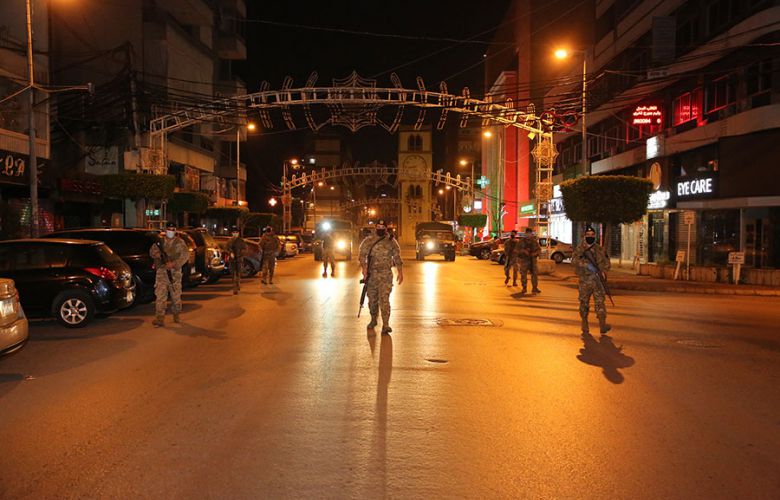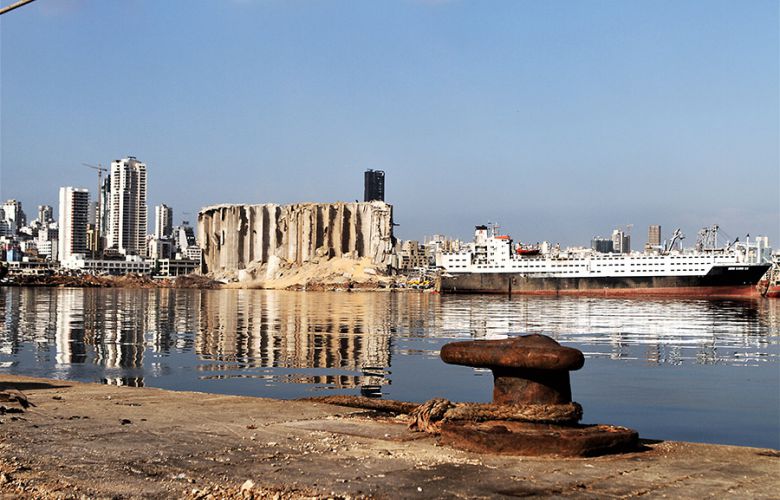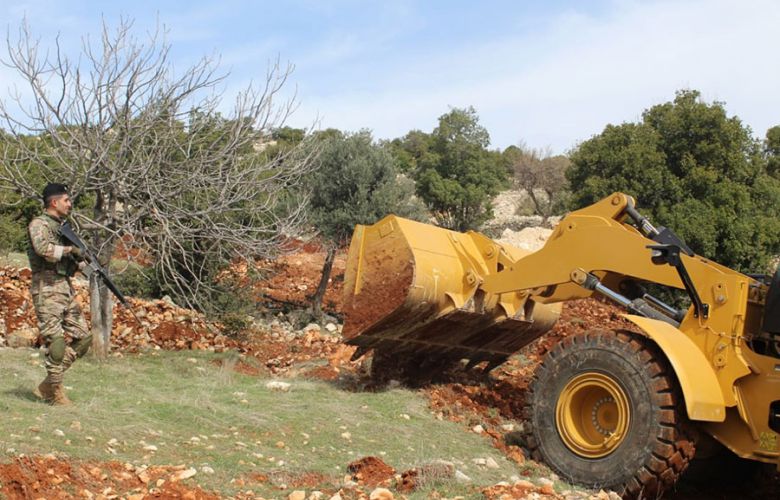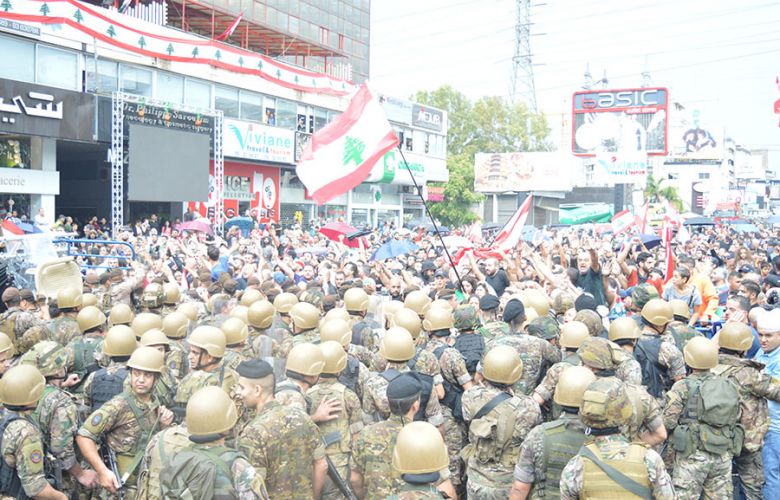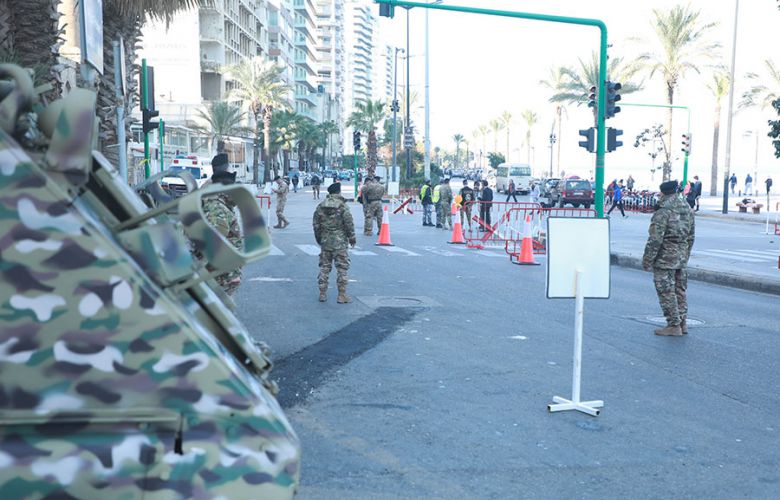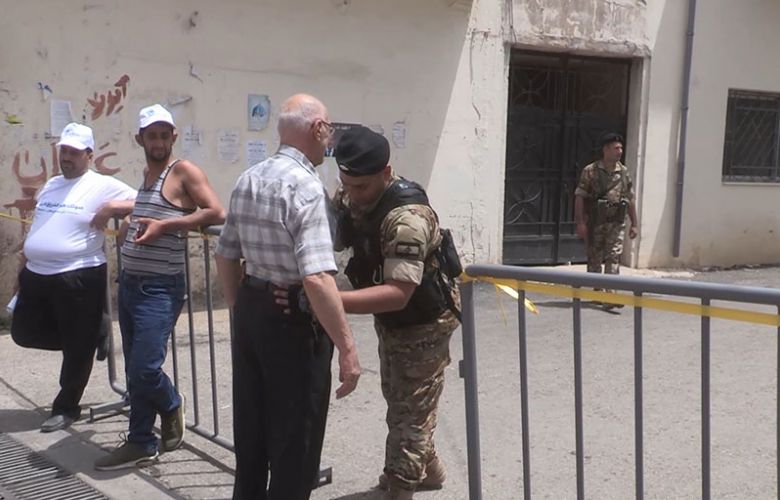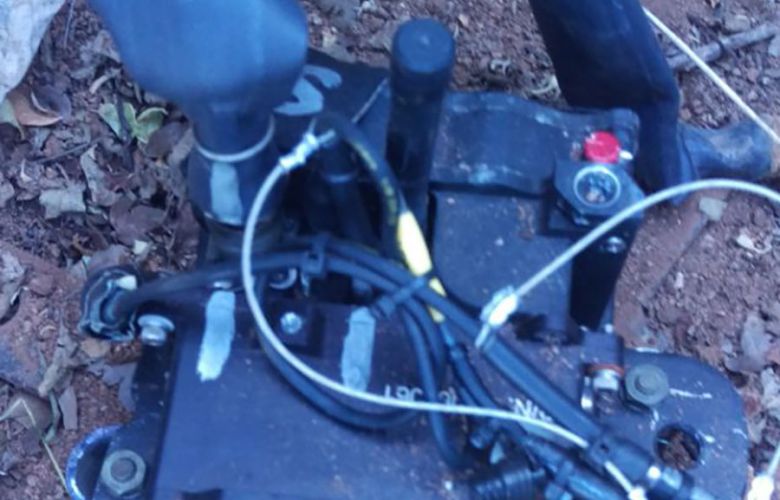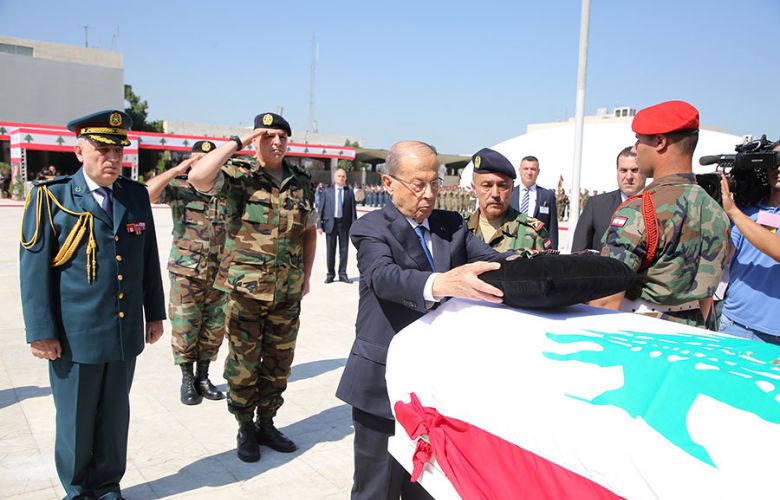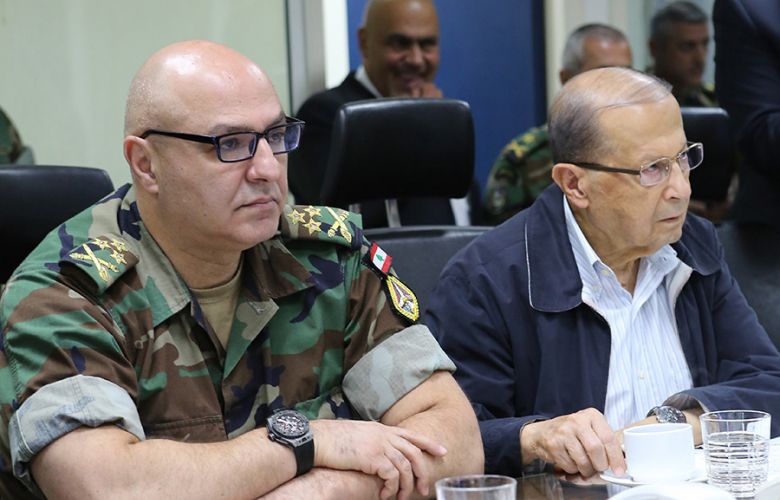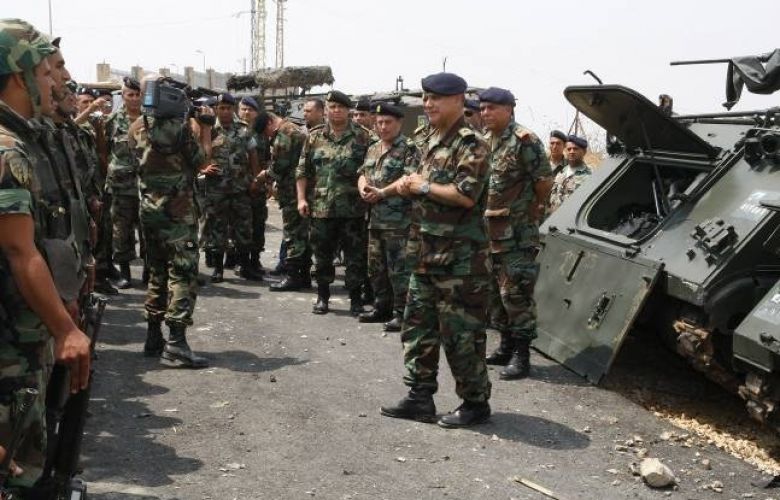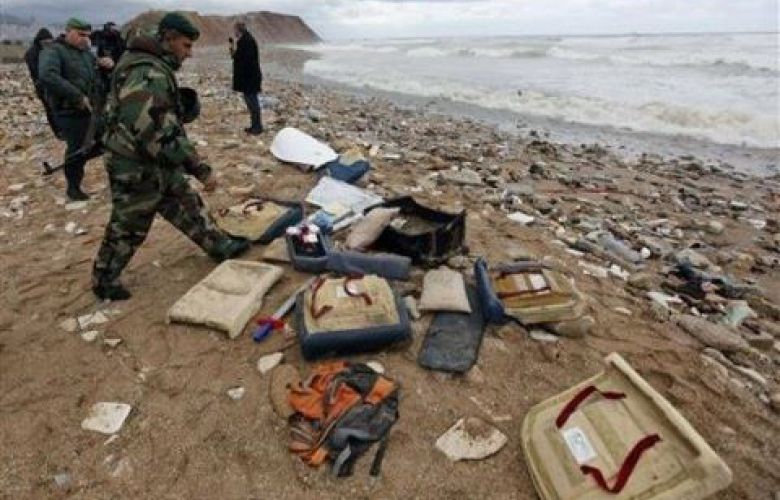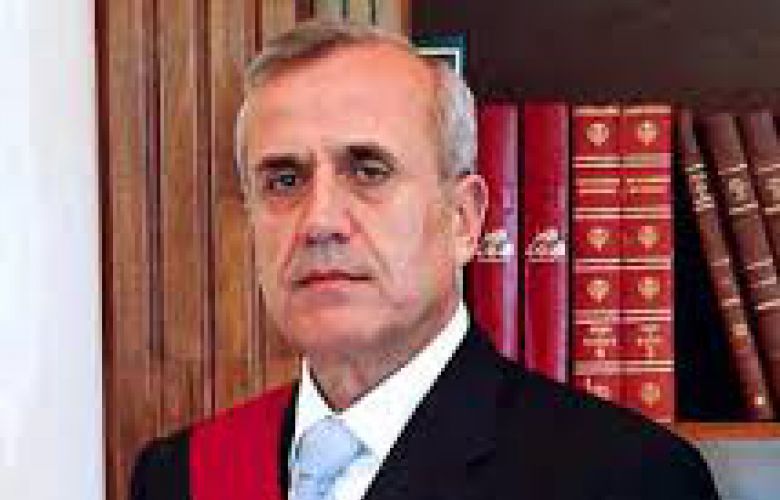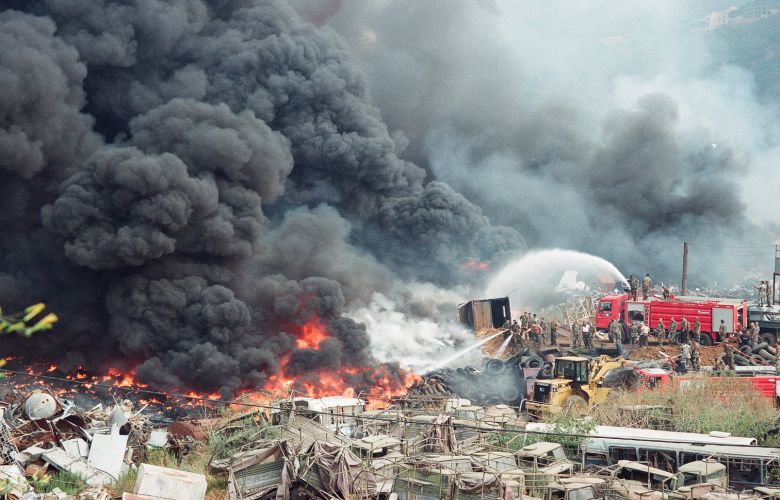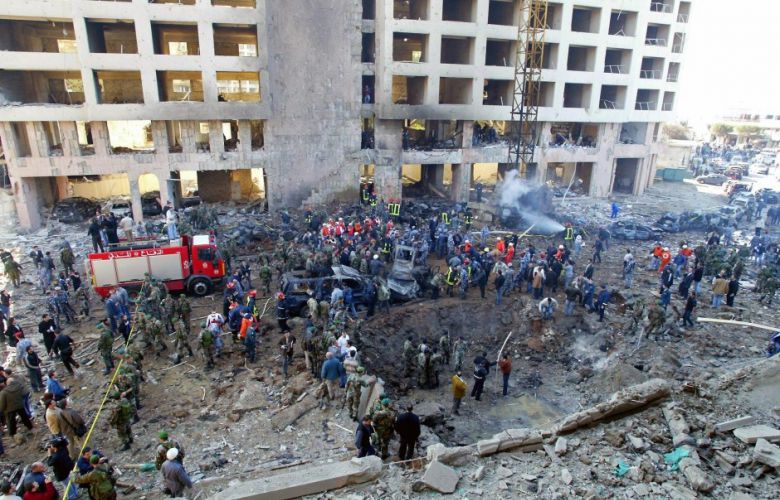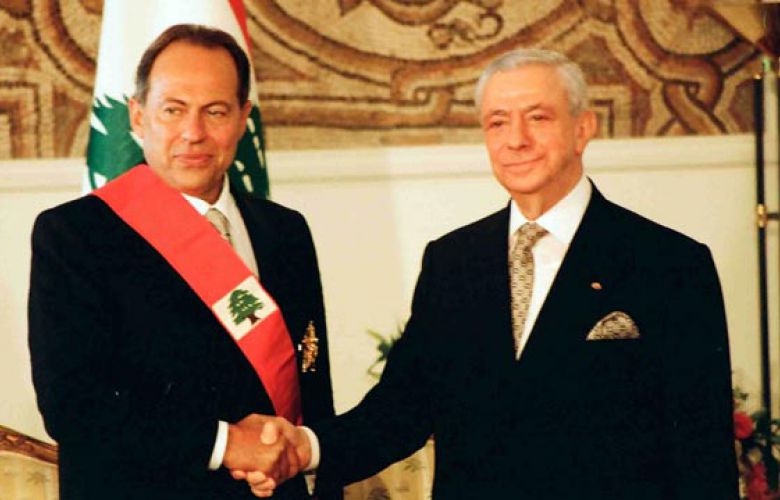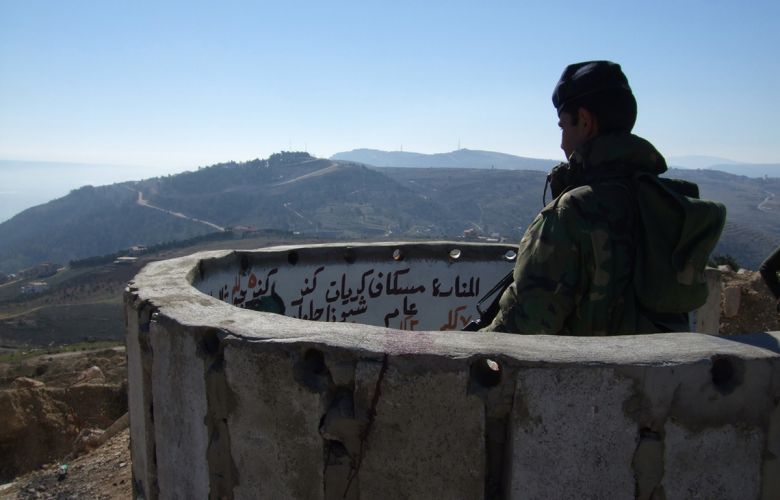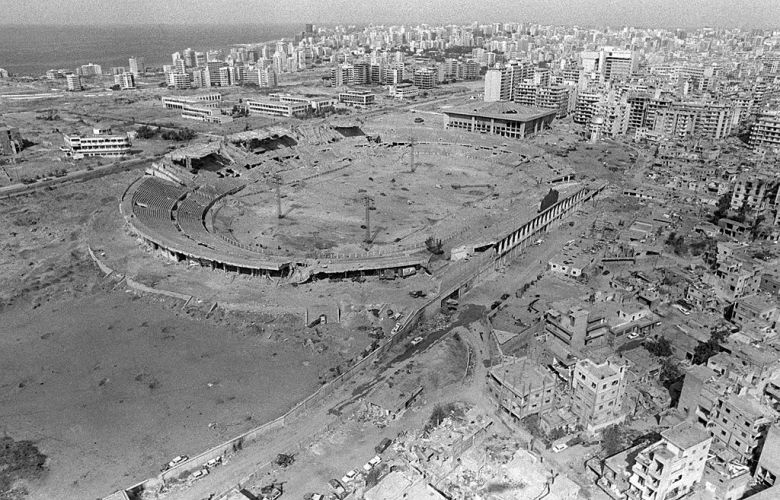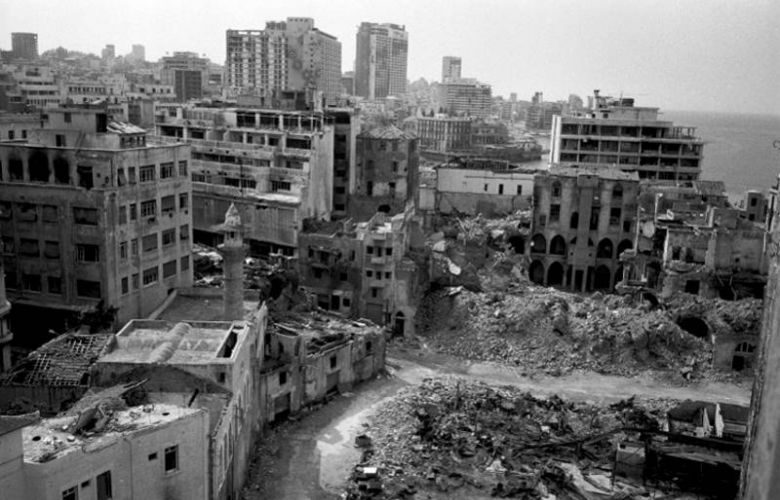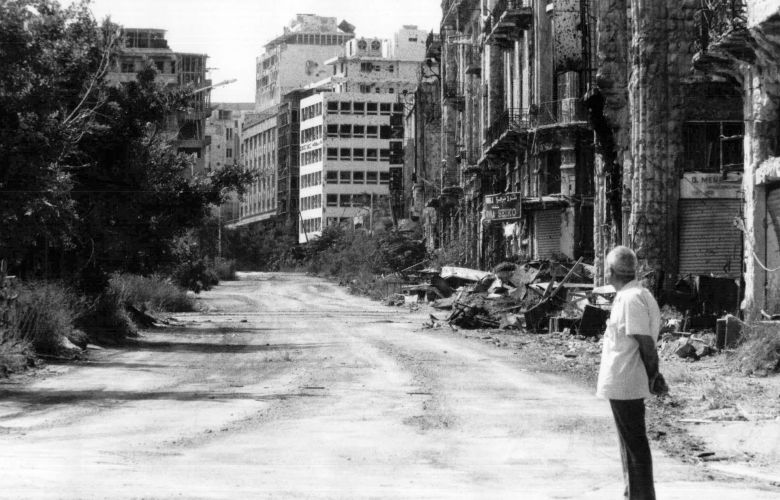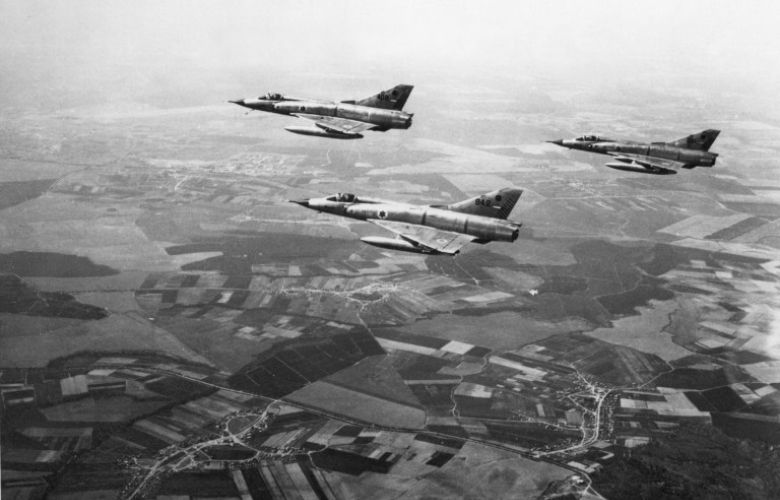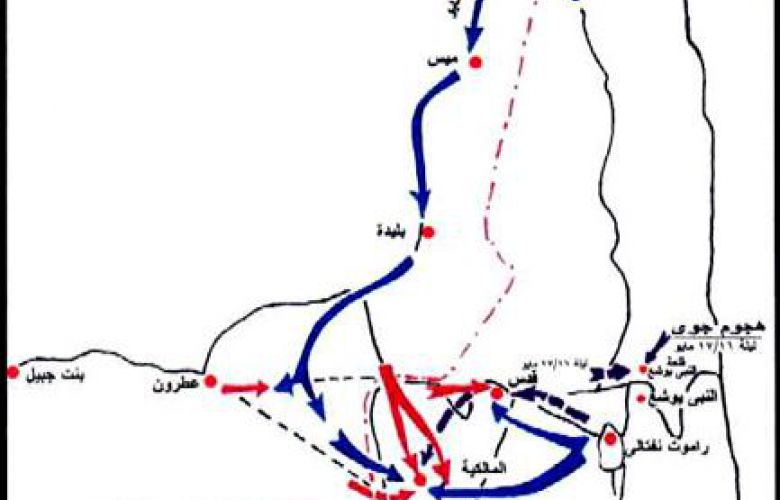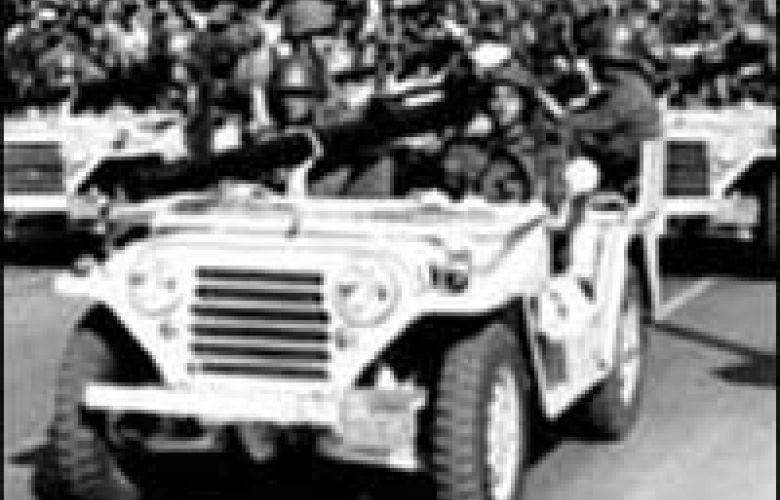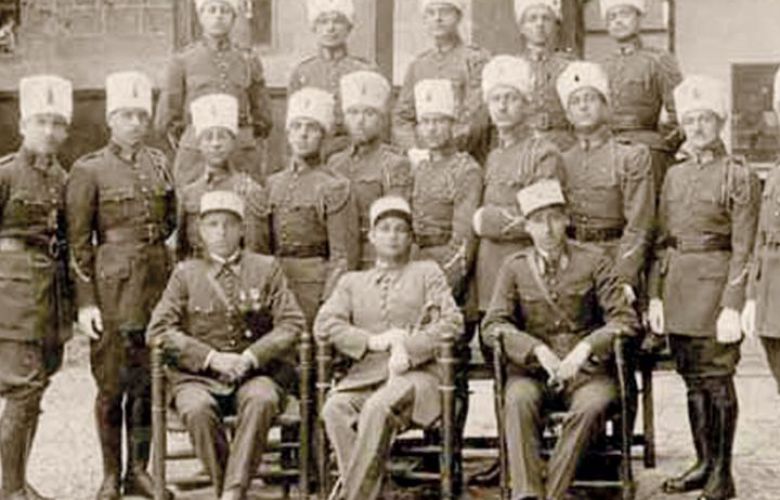Historical Events
Curfew from 7 p.m. until 5 p.m. in all areas2020
On 28/3/ 2020, as a part of the National Mobilization Plan to combat the Covid-19 virus, the army units deployed in all regions implemented exceptional measures pursuant to the curfew decision from 7:00pm until 5:00am, and to monitor the adherence to the closing order by various institutions. The Army Command stressed the necessity of full commitment to apply the General Mobilization and called on citizens to adhere to the procedures and instructions to stay at their residences, and not to leave them except in extreme cases of necessity. In addition, no gathering is allowed and for any reason, at the risk of being charged.
The port of Beirut blast and its consequences2020
On 04/08/2020, a catastrophic blast took place in the port of Beirut after a large quantity of ammonium nitrate exploded. The nitrate was stored inside hangar number 12.
- The blast claimed more than 206 lives, including two officers and five soldiers, and wounded more than 6,000 others. The area around the port was also destroyed, with hundreds of homes and institutions destroyed and hundreds more damaged.
- Upon the disaster, all military units in and around Beirut were deployed, and the LAF began working alongside aid agencies such as the Civil Defense and the Red Cross to evacuate the wounded, retrieve bodies, and remove debris to make way for ambulances. The units were also tasked with securing the damaged residences so against robbery and trespassing.
- Subsequently, specialized regiments assumed sensitive tasks within the port, such as searching for and removing dangerous materials by the Engineering Regiment, dismantling the massive falling pieces of debris by the Independent Works Regiment, and participating in the investigation of the causes of the blast and the discovery of chemical evidence.
- The army was also charged with distributing state-approved financial aid to citizens affected by the blast. A committee was formed to inspect the buildings and divide the affected areas based on the extent of damage. The allocated funds were distributed in record time.
- This phase marked broad international solidarity with Lebanon, with large amounts of aid in various forms, including foodstuff, consumables and medical equipment, and several field hospitals were set up to treat the wounded. The army was tasked with organizing the process of receiving and distributing aid to citizens.
Military units carried out a wide deployment to maintain security and stability after a wave of demonstrations in various Lebanese regions2019
On 17/10/ 2019, a wave of demonstrations erupted in various Lebanese regions to protest the living conditions, leading to riots, trespassing on public and private properties and the firing of fireworks towards the security forces. The military units carried out a wide deployment to maintain security and stability in the region.
The arrest of one of the most dangerous individuals wanted by the judicial authorities Mustafa Al-Hujairi, known as "Mustafa Anis"2019
On 24/1/ 2019, in a specialized operation, a force from the Intelligence Directorate raided in Arsal the residence of one of the most dangerous individuals wanted by the judicial authorities, Mustafa Al-Hujairi, known as "Mustafa Anis". He threw a grenade towards the aforementioned force, trying to escape, which lead its members to return fire before arresting him. He was injured and transferred to a nearby hospital for treatment. Various firearms were seized in his residence.
The wanted al-Hujairi had participated alongside terrorist organizations in attacking LAF units during the events in Arsal in 2014, as well as an Internal Security Forces patrol during an attempt to arrest him on an earlier date. He had thrown a grenade towards the aforementioned patrol, which led to the injury of a number of its personnel. He had also been involved in the trafficking of weapons and narcotics; several judicial warrants had been issued for his arrest.
Security measures to preserve the security of parliamentary elections in various Lebanese regions2018
On 5/5/2018, army units completed their deployment around polling stations, maintaining the security of parliamentary elections in all Lebanese regions. They placed temporary and permanent checkpoints and carried out foot and vehicle patrols. The army command called on citizens to fully respond to the measures taken
The arrest of Mustafa al-Hujairi, known as “Abu Taqiya”2017
On 15/11/2017, an army unit from the Intelligence Directorate arrested in Arsal, Mustafa al-Hujairi, known as "Abu Taqiya", who was turned in to the competent judicial authorities.
Remains of soldiers kidnapped by Daesh recovered in the outskirts of Arsal 2017
On 27/08/2017, as part of a follow-up to the soldiers kidnapped by the terrorist group Daesh, the remains of eight persons were recovered in Wadi al-Dib in the outskirts of Arsal, as well as the remains of another person in the outskirts of Arsal. On 29/08/2017, the remains of another person were also found in the Al-Rahwa in the outskirts of Arsal. All of them were transferred to the Central Military Hospital to conduct DNA tests and to identify the bodies.
A spying device belonging to the Israeli enemy seized by a patrol from the intelligence directorate in the outskirts of Kafr Shuba town2017
On 9/9/2017, a patrol from the Intelligence Directorate seized in the outskirts of the town of Kafr Shuba, north of the Ruwaysat al-Alam, a spying device belonging to the Israeli enemy. The device was a thermal camera placed inside a box made of fiberglass and connected to two anti-personnel landmines.
A specialized team from the Engineering Regiment dismantled the device and took the appropriate measures.
The arrest of the former mayor of Arsal Ali Al-Hujairi 2017
On 09/09/2017, a patrol from the Intelligence Directorate arrested in Arsal its former mayor Ali al-Hujairi, according to his own confessions and as a result of investigations conducted with one of the detainees.
The arrestee turned in to the competent judicial authorities.
Army command mourns the martyrs who were kidnapped by Daesh and holds a memorial ceremony for them2017
On 08/09/2017, the Army Command mourned the martyrs who were kidnapped by Daesh and held a memorial ceremony for them in the courtyard of the Ministry of National Defense, chaired by His Excellency the President of the Republic. The martyrs’ names are as follows: First Adjutant Martyr Ibrahim Samir Mugheet - Corporal First Class Martyr Ali Zeid al-Masri - Corporal First Class Mustafa Ali Wahbi - Private First Class Martyr Seif Hassan Dhiban - Private First Class Martyr Mohammed Hussein Youssef – Private Martyr Muqbel Hassan – Private Martyr Hussein Mahmoud Ammar - Private Martyr Ali Youssef al-Hajj Hassan - Private Martyr Abbas Ali Madlij - Private Yehya Mohammed Ali Khodr.
Suicide attack thwarted at Costa café in al-Hamra2017
• On 21/01/2017, in a specialized and joint operation in coordination with the Information Branch of the Internal Security Forces (ISF), an army unit from the Intelligence Directorate thwarted a suicide attack in Costa Café in Hamra area, which resulted in the arrest of the suicide bomber Omar Hassan Al-Assi, who was carrying his ID card. The detainee tried to force his way into the café, which led to a fistfight with the military force. The explosive belt carried by Al-Assi was seized and disarmed. He was immediately transferred to the hospital for treatment.
On 22/01/2017, an army unit raided the residence of the terrorist Al-Assi in Sharhabil – Saida and arrested four suspects. The military expert’s inspection of the explosive belt revealed that it contained 8 kg of highly explosive material, in addition to a quantity of iron balls, with the aim of causing as many casualties as possible. The arrestees were turned in to the competent judicial authorities.
Dawn of the Outskirts2017
On 19 / 8 / 2017, the Armed Forces Commander General Joseph Aoun General Joseph Aoun declared the beginning of Operation “Dawn of the Outskirts” against the terrorist organization “ISIS” in the outskirts of Ras Baalbek and el-Qaa. On the same day, His Excellency the President of the Republic General Michel Aoun visited the operations room in the Army Command where he was received by the Armed Forces Commander in the presence of the Army Chief of Staff Major General P.S.C Hatem Mallak and senior army officers. The operation ended on 27 / 8 / 2017 and the Army resorted in the battle to a wide range of weapons such as the artillery, the air force, rockets, and machine guns. The operation resulted in the decisive victory over the terrorists and the liberation of the outskirts of Ras Baalbek and el-Qaa from terrorist presence.
A qualitative swift operation against a group from the terrorist organization “ISIS” in the barren lands of Ersal (2016)2016
On 03/02/2016, in Wadi el Araneb – Ersal, an Army force executed a qualitative swift operation at the headquarters of a terrorist group belonging to the terrorist organization “ISIS” that was planning to attack army posts and kidnap citizens in Ersal. As a result, army forces succeeded in taking down 6 armed terrorists including a major leader in the mentioned organization as well as confiscating a number of weapons, ammunition, hand grenades, explosive belts, mufflers and 2 vehicles. Moreover, another army force raided a field hospital used by ISIS in the same region, and arrested 16 terrorists with no mentionable injuries being recorded among the army that has shown ultimate professionalism in tracking down the group and arresting its members. Local, regional and international milieus expressed their appreciation and admiration to the efforts of the military forces and commended the successive accomplishments and victories they have realized in the face of these groups.
What happened in Ersal was bigger than a battle against terrorism and what the soldiers have accomplished was bigger than a victory, for the heroic confrontations that the army went through and the pure blood that was shed on the ground of these barren lands prevented the realization of the terrorists’ scheme to “change Lebanon’s aspect, probably even erase it from the map as a state.” The army thwarted their schemes and destroyed their hopes of establishing their so-called emirate in the Lebanese territories, and their dreams to reach a naval exit to the beach.
Executing a qualitative swift raid in the barren lands of Ras Baalbeck2015
On 07/04/2015, an army force executed a qualitative swift raid in the barren lands of Ras Baalbeck against terrorist groups, following information provided about logistic and combat preparations made by these terrorist groups. Therefore, army forces clashed with these groups with all sorts of weapons which resulted in a number of deaths and injuries among them as well as massive losses in weapons and equipment with no injuries being recorded among soldiers.
The army taking over 2 strategic heights in the barren lands of Ras Baalbeck (2015)2015
On 26/02/2015, army units executed a swift attack in the barren lands of Ras Baalbeck against terrorist groups where they succeeded in taking full control over 2 strategic heights at the Lebanese – Syrian borders and chasing away armed individuals, with no injuries being recorded among soldiers. This operation took place in the frame of providing security for rear army posts as well as villages adjacent to the eastern borders.
The confrontation with terrorist groups in the barren lands of Ras Baalbeck (December – April 2015)2015
On 23/01/2015, terrorist groups attacked a front army post in Tallet el Hamra. Therefore, soldiers from the post confronted the attackers with all sorts of weapons and prevented them from moving forward. As a result of the resistance of these soldiers and the military reinforcements deployed to the region as well as targeting the gathering locations of terrorists and their infiltration paths with heavy weapons, army forces manages to take control of the mentioned hill and to chase away the attackers, inflicting a large number of injuries and deaths among them. The army offered 8 martyrs during the clashes in addition to a number of injured individuals.
The Ersal battle (August 2014)2014
On 02/08/2014, following the arrest of terrorist Imad Jomaa at an army checkpoint in Ersal, massive gatherings of armed individuals suddenly appeared. These individuals performed a vast attack on all front military posts in the region and that in parallel with targeting an ISF platoon in the mentioned village. However, army forces responded swiftly and directly and executed a well planned attack operation, during which they managed to release military posts and chase away the perpetrators towards the barren lands of the region, leading to several injuries and deaths among them. The army offered during this critical confrontation 24 martyrs and 86 injured soldiers, while terrorist groups kidnapped 21 members of the army and 15 members of the ISF. Later on, 5 among the kidnapped members martyred, 4 belonging to the army and 1 to the ISF, in a savage manner that is far from being human or ethical. On 31/08/2014, 4 army soldiers were liberated and 01/12/2015, based on political and filed negotiations, 3 army members were liberated along with 13 ISF members.
The Tripoli confrontation October 20142014
On 24/10/2014, as a result of arresting a terrorist in Doniye, a number of armed supporters attacked army members and posts, causing the martyrdom of several soldiers including 2 officers. Consequently, the army executed a wide military operation in order to put an end to the situation and to terminate the phenomenon of armed individuals in some regions of Tripoli and Akkar. The operation ended in chasing away the armed individuals as well as capturing and killing a large number of them, while the army lost 11 martyrs, including 3 officers. This battle was characterized with speed and high competence that were clear while putting a halt to the abnormal situation (during 24 hours) and spreading the authority of the state on all regions torn with clashes.
The Abra battle June 20132013
On 23/06/2013, armed groups related to terrorist Ahmad el Aseer promptly attacked an Army checkpoint, leading to the martyrdom of 2 officers and a soldier and the injury of another. The aim of this group was to target the Army and stir tumult in the south. During 2 days of fierce confrontations, Army forces managed to totally eradicate this group and arrest a large number of its members. During the battle, the army offered 20 martyrs and dozens of injured.
The Wazzani confrontation August 20112011
In a similar incident that occurred on the 1st of august 2011, army forces deployed in the region of Wazzani confronted an Israeli patrol that trespassed 30 meters into the withdrawal line in the Lebanese territories. As a result of the confrontation, the patrol of the enemy was forced to go back to its posts, with no injuries being recorded among the army members.
The Edaysse confrontation August 20102010
On the 3rd of August 2010, an Israeli patrol trespassed the technical line at the outskirts of Edaysse into debated Lebanese territories, which led the army force deployed in the region to confront the patrol and clash with it for several hours. During the confrontation, the enemy used heavy weapons against army posts and residences of civilians, which resulted in the martyrdom of 2 soldiers and a citizen as well as the injury of others, while the enemy lost several martyrs and injured individuals. The confrontation came to a halt with the withdrawal of the attacking patrol back to its posts.
The crash of the Ethiopian aircraft January 20102010
On 25/01/2010 at 2.30, while a Boeing aircraft belonging to the Ethiopian airlines was taking off from Rafic Hariri international airport with 90 passengers on board, the aircraft burst in fire then soon crashed at sea facing Nehme, 8 Kms from the shore. Units from the navy, the air force and the navy commandos immediately intervened with the assistance of helicopters and naval boats belonging to the UNIFIL. After managing to precisely locate the aircraft, these units executed a wide search operation that eventually led to the discovery of both black boxes, and the retrieval of the aircraft wreck along with most bodies of victims who were on board. This operation executed by the Army was a big success and gathered a lot of appreciation on the local and international scale, as to the competence of the Lebanese soldiers, their bravery and their speed in performing the mission.
The war of Nahr el Bared May – September 20072007
On 20/05/2007, the terrorists of Fath el Islam that was based in Nahr el Bared Palestinian camp – North Lebanon, executed a prompt and deceiving attack on some army posts in the mentioned camp and the suburbs of Tripoli, in an attempt that targeted the state and its institutions and aimed to terrorize the army and establish an emirate in the North. However, the army regained force immediately through the prompt response of its units, where it managed to regain its posts, defeat the terrorists and arrest some of them as well as cordon off the camp. Then the army command took the decision to gradually terminate the situation in a military matter. Moreover, on the 2nd of September of the same year, the army kept its promise to the Lebanese people to keep its field control of the last terrorist post in the camp in order to demolish the biggest terrorist organization known by Lebanon, because of which it offered 171 martyrs and hundreds of injured individuals during this cruel battle.
The July aggression 20062006
Once again, the Israeli enemy, channeled its destructive weapons towards Lebanon in an open war that began from the south on the 12th of July 2006, which quickly spread to different Lebanese regions and cordoned off Lebanon on Land, at sea and in the air with fire in a systematic destruction process of Lebanon’s infrastructure and establishments that also purposely targeted innocent citizens in their homes, workplaces and while commuting. The aggression also targeted army posts all over Lebanon and committed dreadful massacres, particularly at the independent works regiment in Jamhour and in the posts of Wajh el Hajar and Aabde that belong to the navy in the North, causing the fall of 47 martyrs and several numbers of injured individuals, where the blood of soldiers fused with the blood of innocent citizens. During this war, the army reflected the image of a resisting nation in the battlefield, as army units at their deployment locations performed their defensive role with all available capabilities, through confronting enemy drones and thwarting several attempts of landings and infiltration. Army units also continued to perform their security and development missions all over the country, ready to thwart any internal tumult and to firmly confront anyone who attempts the target security and stability in the light of major displacement cases and recent circumstances and changes. On 14 August at 8 am, the Israeli aggression came to a halt in execution of the Security Council resolution 1701 issued on 11/08/2006, which stipulated the cessation of all combat actions. Therefore, the refugees started their journey back to their lands and homes and the Lebanese army rushed to the southern borders after over 3 decades of absence, and that in execution of the resolution of the Lebanese government stipulating the deployment of the army in the south of Lebanon reaching the blue line, and to spread the authority of the state in that region just as the other Lebanese regions, as well as supporting the resistance of citizens and keeping up with the reconstruction of their villages. This mission was synchronized with the deployment of army forces all along the Lebanese borders on the land and at sea in order to control passages and prevent all kinds of smuggling actions.
The assassination of martyr Prime Minister Rafic Hariri (February 2005)2005
On February 14 2005, the convoy of former Prime Minister Rafiq Hariri was attacked with a major explosion near St.George Hotel – Downtown, leading to his martyrdom along with deputy Bassel Fleyhan and a number of his bodyguards as well as citizens who were in the mentioned region. The explosion also resulted in the damage of numerous buildings and cars in the area.
With the martyrdom of Prime Minister Hariri, the state and its institutions including the Army, lost a statesman who had highly contributed in the construction process, politics lost a highly consensual man, the economy lost a man who legendarily imprinted reform and construction in Lebanon, and the world lost an outstanding man who was able to be a pioneer among outstanding people.
The participation of the Army in the search for the passengers of the airplane that crashed in Cotonou 20032003
On 25/12/2003, a Boeing 727 passenger airplane crashed near Cotonou airport – Benin, where soldiers from the Marine Commandos regiment participated in a unique mission outside the Lebanese territories, in retrieving the victims of the crashed airplane. This participation efficiently contributed to retrieving the bodies of the passengers and to saving the lives of 22 passengers, among them are 16 Lebanese passengers. This incident is considered one of the worst air catastrophes, especially that the passengers were headed to Lebanon to spend the holidays with their families.
The Liberation May 20002000
In the beginning of the 90s, the Army Command promptly deployed half of the army staff at the confrontation lines with the Israeli enemy in the South and in West Beqaa and issued orders to confront the Israeli enemy with all available means and ways. As a result of the unity of the national stance and the resistance of the army in its posts as well as the fast attacks of resistance in an unprecedented war, the Israeli enemy was forced to retrieve from the widest part of the South and West Beqaa, therefore leading to the liberation in May 25 2000.
The Donniye battle January 20002000
On 31/12/1999, an army patrol went under attack by an armed group belonging to "Takfir wal Hejra" terrorist organization in Donniye – North Lebanon. Therefore, the army performed a wide military operation against this group, which resulted in its abolishment in few days, during which the army lost 1 officer and 7 martyr soldiers in battle. This organization is considered the main cause for the infiltration of the Takfiri mentality in Lebanon, due to the variety of the nationalities in it, the size of its weapons and equipment and the ideas, ideology and targets it used to adopt and aim to realize.
Operation Grapes of Wrath in April 19961996
In April 1996, the Israeli enemy launched a ferocious operation that lasted 16 days and it was given the name “Grapes of Wrath” where the Israelis used the policy of “burned ground” and reached the apogee of its criminal acts with the notorious massacre of Qana when the Israeli forces targeted a UNIFIL post which was used as a shelter by unarmed innocent citizens. The shelling led to the martyrdom of hundreds of civilians. Army units deployed in the south confronted the Israeli aggression with all the available means at their disposal despite the fact that their posts were directly targeted. The Army’s tenacity and steadfastness had the greater impact in boosting the people’s tenacity and the return of displaced citizens as soon as the operation ended.
The Settlement operation in july 19931993
In july 1993, the Israeli enemy launched a large scale attack against Lebanon that lasted 7 days. The operation was given the name “Settlement” and targeted facilities, bridges, power plants and residential areas causing casualties in lives and a huge destructions in properties and infrastructure. The attack caused a large wave of exodus from the targeted areas toward the internal regions in Lebanon. The Army was once again present to confront the aggression and its forces confronted the air raids. The Army stood by its citizens during this exodus, assisted them and protected them while traveling into safer regions and gave its support to remove the traces of this aggression in the aftermath.
Dawn of the South battle in July 19911991
Following the signature of the National Accord document between the Lebanese sides and ultimately put an end to the internal incidents, the Lebanese government issued a decision which stipulated the dissolution of all the militias and spreading state authority over all the Lebanese territories. However, a number of Palestinian organizations refused to withdraw from villages to the east of Sidon and did not return to the refugee camp of Aïn el-Helwe. This development prompted the Lebanese government to charge the Army with the mission of putting an end to this aberrant situation. The Army managed to implement the government’s decision following rough clashes with these organizations where the Army suffered from casualties in lives and wounded troops.
Reunification of the Army in October 19901990
Following the signature of the Taef Accord on the 30th of September 1989, the unification and establishment of the Military Institution was initiated based on 3 the following major pillars: establishing national constants and the military doctrine which is in its turn based on the content of National agreement and adopting the institutional approach at work and providing the needed human resources and material needs to enable the Army to conduct the required missions.
The Army Command has succeeded to initiate the Institution’s building process in a record speed since work was set in motion according to clear precise standards the thing that boosted the Army and transformed it into the State’s main pillar in the journey of the country’s renaissance. The first steps in the Institutions rebuilding journey included the comprehensive merge and the change that affected the deployment of military units and this has led to put aside all confessional aspects and favoritism in addition to consecrating the concept of loyalty to the institution. This step was associated with adopting the institutional approach at work in a way that made productivity and competence the basic factors as to promoting the troops, permutations and following training courses. In parallel, the Army Command has firmly adhered to distance the Institution from political gravitations in order to preserve its prestige and unifying national role. In the field of providing the Army with the needed equipment and weapons to empower the Army in order to perform its duties, the Army relied on the concept of providing the necessary needs without burdening the State Treasury with insupportable costs. This process was achieved through the following steps:
A – Initiating a maintenance and upkeep workshop for the available weapons and equipment.
B – Receiving the weapons of the militias and using the useful arms.
C – Benefiting from the offers presented by a number of friend countries to purchase various weapons and equipment with symbolic prices.
D – Accepting donations from Arab and friend countries which included military helicopters, reconnaissance airplanes, military boats, heavy artillery, tanks, troop carriers, military vehicles in addition to different equipment and ammunition.
In parallel with the supply process, training and educational efforts were also initiated to remain up to date with the development in the military field and developing the capabilities of the troops by intensifying training courses at the level of units and forces as well as following training courses in the country and abroad on all the levels.
The 1982 Invasion1982
On the 6th of June 1982, the Israeli enemy launched another invasion under the name “Peace of the Galilee” where its armed forces reached the capital Beirut, the west Bekaa and Mount Lebanon. The casualties during this operation amounted to 50 thousand martyrs and injured individuals in addition to the huge destruction in the infrastructure.
The Army confronted this aggression with all the available means while its posts were subjected to ferocious raids that led to the destruction of several barracks and military posts mainly the barrack of Mohammad Zgheib in Sidon and the barrack of Issam Chamoun in Nabatieh. The Army gave many martyrs and many troops were injured during the confrontations.
The 1978 Invasion1978
On the 14th of March 1978, the Israeli enemy forces invaded parts of South Lebanon as part of the “Litani Operation” which lasted 7 days and was concluded with the issuance of Resolution 425 which stipulated the withdrawal of all enemy forces from all invaded territories. This invasion resulted in heavy casualties and material damages and the Lebanese Army valiantly confronted the raiding aircrafts and advancing units and gave many martyrs and many soldiers were injured during the confrontations.
The Incidents of 19751975
On the 13th of April 1975, the strife incidents broke out in Lebanon for several reasons, mainly due to the repercussions of regional conflicts over the Lebanese internal arena and the emergence of the Israeli factor that aimed to strike at the Lebanese people’s unity and the formula of coexistence that joined between them.
In view of the lack of the State’s unified political decision, the Army’s role in its national concept was dismissed and thus it became unable to deter the strife. Thus, the bloody incidents persisted for long years and the Israeli enemy took advantage of this fact to implement its schemes and turn its avidities into reality. Accordingly, the Israeli enemy forces invaded Lebanon and wreaked havoc and this invasion threatened the Lebanese entity to disintegrate and founder. However, these incidents and despite their severity never hindered any interactions and gathering joining brothers in arms and the Lebanese people kept on betting on its national unifying role and this was accomplished in the beginning of the nineties through the Document of National Accord which put an end to the internal incidents and gave the Army back its long sought role in establishing a new era of peace and stability. This achievement enabled the national resistance to step up the fight against the Israeli enemy and ultimately managed to liberate the land.
The Truce Agreement (March 1949)1949
As a result of the United Nations’ intervention to end the fighting between the Arab on one hand and the Israeli enemy on the other hand, an agreement was reached in 1949 to sign a Truce agreement which included each Arab country separately while Lebanon signed the Truce agreement on the 23rd of March of the same year. However, the Israeli Army did not abide by the stipulations of this agreement and this had led to continued clashes between the Lebanese Army and the Israeli enemy forces at the border.
The 1967 war1967
On the 4th of June 1967, the Israeli enemy waged a large scale war against the neighboring Arab countries (Syria, Egypt and Jordan). Despite the fact that the War did not include Lebanon, this did not deter the Lebanese State from providing logistic and health support to the Arab States to the Arab countries. Furthermore, following the cease fire, Israel occupied the Lebanese Farms of Chebaa and the hills of Kfarshouba in the southern region of Arkoub. The Israeli occupation of these Lebanese territories continues until this day.
The incidents of 1958 and the election of Major General Fouad Chehab as President of the Lebanese Republic1958
Armed incidents broke out in 1958 and included a number of Lebanese regions due to the division in the stances of the Lebanese sides vis-à-vis the Baghdad Pact.
The Army intervened led by its Commander Major General Fouad Chehab and managed to put an end to the armed clashes and gathered the weapons in order to preserve public order and safeguard civil peace.
The battle of Malkieh 1948
Between 15/5/1948 and 6/6/1948, the newly created Lebanese Army engaged in a ferocious battle against Israeli enemy forces which occupied the town of Malkieh in northern Palestine. The Lebanese Army managed to liberate the town and handed it over to the Arab Salvation Army which was formed at the time. The commander of the attacking Lebanese unit Captain Mohammad Zgheib martyred during the battle alongside 8 other Lebanese troops while enemy forces suffered from severe casualties and damages. The Lebanese soldiers showed extreme courage during combat despite the huge disparity in the balance of power.
Handover of military units: on the 1st of August 1945 and setting the date of the Army Day1945
Lebanese, Syrian and French committees convened on the 12th of July 1945 in Masabki Hotel - Chtaura and the meetings resulted in giving the green light for the process of handing over the command of military units according to the following schedule:
- Handover of barracks and all other facilities on the 20th of June 1945.
- Handover of military forces consisting of 20000 troops in Syria and 5000 troops in Lebanon on the 25th of June of the same year.
- Handover of the Command and administration of these forces on the 1st of August 1945 in addition to setting this date to be commemorated at the National Army Day.
The President of the Lebanese Republic Bechara el-Khoury handing over the Lebanese flag to Major General Fouad Chehab on the 17th of June 19441944
On the 17th of June 1944 and as part of the protocol signed between the Lebanese government and the French authority on the 15th of June of the same year stipulating that Lebanese Snipers Regiments reinforced by an armored vehicles detachment will be placed at the orders of the government, Beirut Municipality Stadium hosted a military parade attended by the President of the Republic , the ministers and General Pinet along with his war staff where Major General Fouad Chehab received the Lebanese flag from the President.
The Document of the 26th of July 19411941
The 1941 document represents an outspoken statement by a group of Lebanese officers enlisted in the Special Levant Legion following an attempt made by the French authorities to establish a Lebanese military unit with the aim of assisting in the war with the French in Europe. The mentioned officers had convened in the town of Zouk Mikael at the aforementioned date and took the oath of serving the interests of Lebanon solely and under the Lebanese banner and the command of its national government.
Creation of the Lebanese Snipers Detachments1926
The history of the Lebanese Sniper Regiments or what was later known by the Infantry stretches deep in the days of the French Mandate over Syria and Lebanon since the French mandate authorities in the Levant were the side responsible for the creation of some Infantry regiments (Snipers) consisting of local young men to assist this authority in extending its influence on one hand and to contribute in the establishment of national armies for these countries on the other hand (as per the laws of the mandate). These units were meant to play a role in establishing the national authority following the end of the mandate.
The 1st, 2nd and 3rd Snipers Regiments were created after decisions taken by the mandate authorities during different stages following the desires and needs of the mandate. These regiments included in their ranks Lebanese and Syrian individuals with the predominance of the Lebanese individuals. However, the Command and some of the major posts in the ranks of these regiments were governed by French officers and Noncommissioned officers.
The situation remained as such until an agreement was reached between the Lebanese and Syrian governments on one hand and the French mandate authorities on the other hand to hand over the command of these forces which were known by the “Special Forces” starting the 1st of August 1945.
Creation of the Levant Legion (1916)1916
The Army’s journey with independence began with the enlistment of groups of young men in the Legion of the Orient which was established by the allied forces in the Arab region in 1916 as a manifestation of national struggle. The young men specified at that time that their enlistment contracts should include 2 stipulations. The first stipulation stated that they shall only fight the ottoman forces and the second highlighted their enrolment in the Allied Forces troops for the sake of liberating Lebanon. In 1918, the Levant Legion included in its ranks the First Lebanese Army detachment which was at that time detachment number 23. The creation of other detachments followed in succession and these forces provided assistance to the Lebanese people and fought alongside with them against the Forces of the French Mandate.













